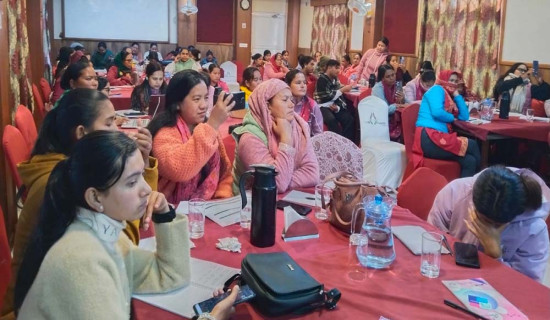- Wednesday, 24 December 2025
Strive For Prevention Of Malaria
Dr. Shyam P Lohani
Malaria affects millions of people in low- and middle-income countries. It has impaired economic growth, child development, learning, health, and productivity, causing a huge economic loss. Malaria is a serious condition and sometimes it produces life-threatening complications. It is caused by a parasite that spreads to humans through mosquitoes. Malaria is still common in tropical and subtropical countries and millions of people are at risk of contracting it.
Burden
Once an infected female Anopheles mosquito bites a human, the causative parasites multiply in the liver before causing infection and destroying red blood cells. When the mosquito bites a person, the parasite enters the blood and reaches the liver, and begins multiplying. After multiplications, the liver releases new malaria parasites back into the bloodstream. These parasites then cause infections to red blood cells and multiply further. Some malaria parasites remain in the liver and do not circulate until sometime later, resulting in recurrence.
Early symptoms include a fever, and over time, it can affect the internal organs, and in serious cases lead to death. It affects people differently and varies widely. Some people develop mild or no symptoms, but others can become severely ill. Malaria is an infectious disease that typically features a fever, chills, and headaches. Sometimes, it progresses to severe or life-threatening complications. It has been found that five types of Plasmodium can cause malaria in humans. However, Plasmodium vivax malaria is the dominant form of malaria in our country representing about 70 per cent of all malaria cases while P. falciparum cases make up the rest. A significant number of cases of malaria are among migrant workers from malaria-prone areas.
In 2020, there were an estimated 241 million cases of malaria worldwide and around 627, 000 deaths (WHO, 2022). WHO had estimated around half of the world's population was at risk of malaria in 2020. It affects people in 87 countries worldwide, especially in Sub-Saharan Africa, Southeast Asia, and South America. An estimated 8.2 million people in Nepal are at risk of malaria infection.
Infants, children under five, pregnant women, patients with HIV/AIDS, and people with low immunity are vulnerable to the disease. In these areas, factors that increase the risk of the disease and easily transmissible include a warm climate, low altitude, urbanisation, and a high population density, and areas with swampy land, open ditches, and unused swimming pools, and leaky water pipes. The mobile population and migrant workers with low immunity are also at higher risk of contracting malaria.
When a person has symptoms but no sign of severe infection or dysfunction of the vital organs are said to be uncomplicated malaria. However, it can progress to severe malaria in cases of low immunity and without treatment. Overall symptoms include fever and chills, sweating, headaches, nausea and vomiting, body aches, weakness, an enlarged liver, mild jaundice, a higher breathing rate, and a general feeling of being unwell.
Sometimes, malaria can progress and affect vital body organs such as liver, kidney and even brain. At this point, malaria parasites may have affected over five per cent of the red blood cells. Symptoms include severe anemia, blood in the urine, changes in blood clotting, impaired consciousness, changes in behaviour, high acidity in the blood and body fluids, seizures, and coma. Severe cases of malaria can become life-threatening and is a medical emergency.
Malaria can cause a number of life-threatening complications. Possible severe complications of malaria include liver failure leading to jaundice, kidney failure, unusually low blood glucose, swelling and rupturing of the spleen, shock with a sudden fall in blood pressure, pulmonary edema, acute respiratory distress syndrome that affects breathing and severe dehydration. With some types of Plasmodium, malaria can become dormant but return months or years later. This occurs because the parasites have dormant stages. During this period, there is no disease produced. However, symptoms can occur if they reactivate especially when immunity is low. Early diagnosis and treatment help most people and they can recover from the disease fully.
Prevention
Preventive drugs and insecticide-treated bed nets have been found effective in protecting people from mosquito bites and malaria infection. A malaria vaccine for use in children who reside in high burden countries has been recommended by the World Health Organisation (WHO). Protective clothing, bed nets, and insecticides can protect travellers from infection. There is preventive medicine for a traveller before a trip to a high-risk area. Malaria parasites have developed resistance to common drugs used to treat the disease; however, new drugs have also been available for those cases.
The WHO has provided a technical framework for all malaria-endemic countries.
The global targets include reducing malaria case incidence and reducing malaria mortality rates by at least 90 per cent by 2030. It has also set targets of eliminating malaria in at least 35 countries by 2030 and preventing a resurgence of this disease in all countries that are malaria-free. Thus, it is called upon all stakeholders to work collaboratively to eliminate malaria and achieve malaria-free status for our country, too.
(Dr. Lohani is the clinical director at the Nepal Drug and Poison Information Centre. lohanis@gmail.com)

















